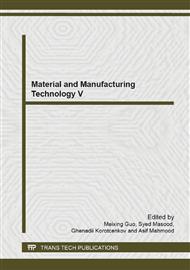p.373
p.379
p.384
p.389
p.394
p.398
p.402
p.408
p.413
Optimization of Friction Stir Welding Parameters with Simultaneous Multiple Response Consideration Using Multi-Objective Taguchi Method
Abstract:
This paper presents an unconventional method to optimize the governing process parameters of Friction Stir Welding (FSW) towards the mechanical properties and weld quality. The optimization approach attempts to consider simultaneously the multiple quality characteristics namely tensile strength, nugget zone hardness and weld quality class using Multi-objective Taguchi Method (MTM). The experimental study was conducted for plate thickness of 6.0 mm under different rotational and traverse speed. The optimum welding parameters were investigated using Taguchi method with L9 orthogonal array. The significant level of the welding parameters is to be investigated by using analysis of variance (ANOVA). Furthermore, the optimum value was analyzed by means of MTM which involved the calculation of total normalized quality loss (TNQL) and multi signal to noise ratio (MSNR).
Info:
Periodical:
Pages:
408-412
Citation:
Online since:
June 2014
Price:
Сopyright:
© 2014 Trans Tech Publications Ltd. All Rights Reserved
Share:
Citation:


